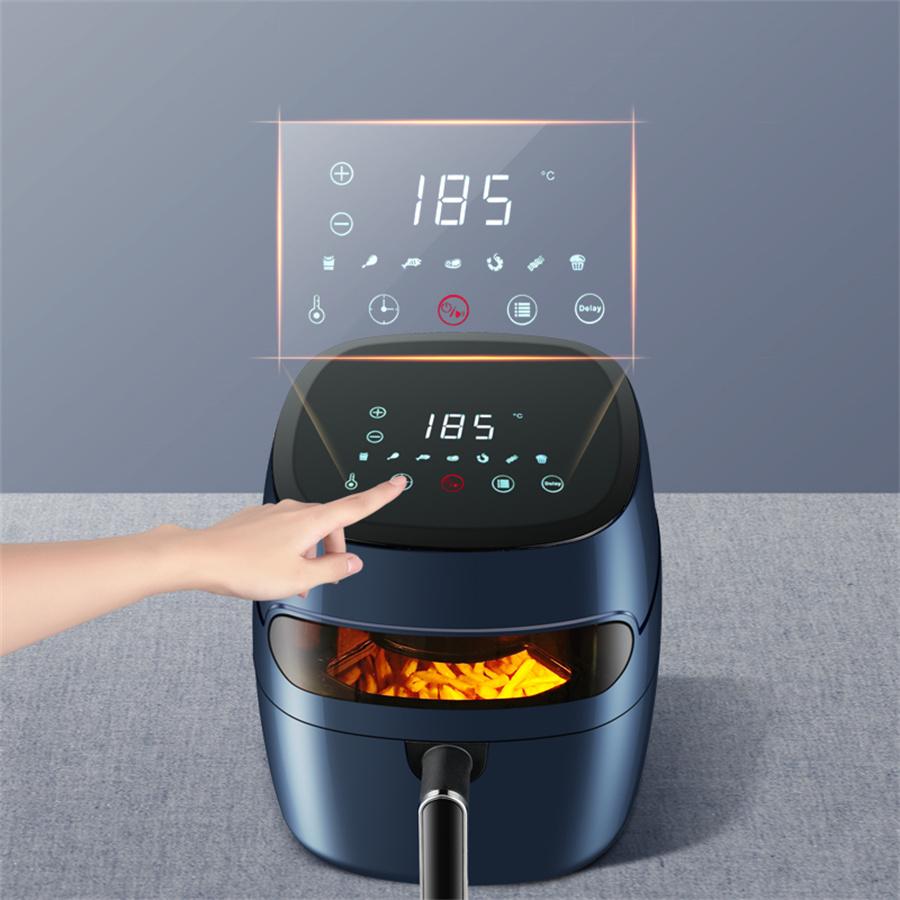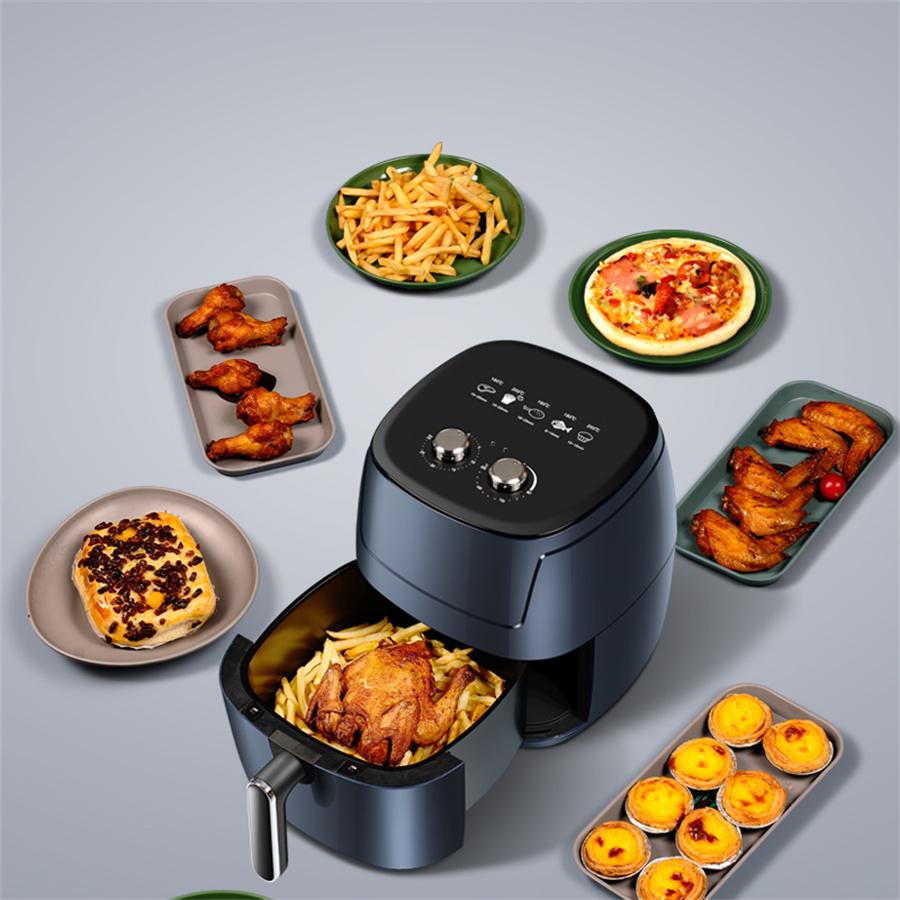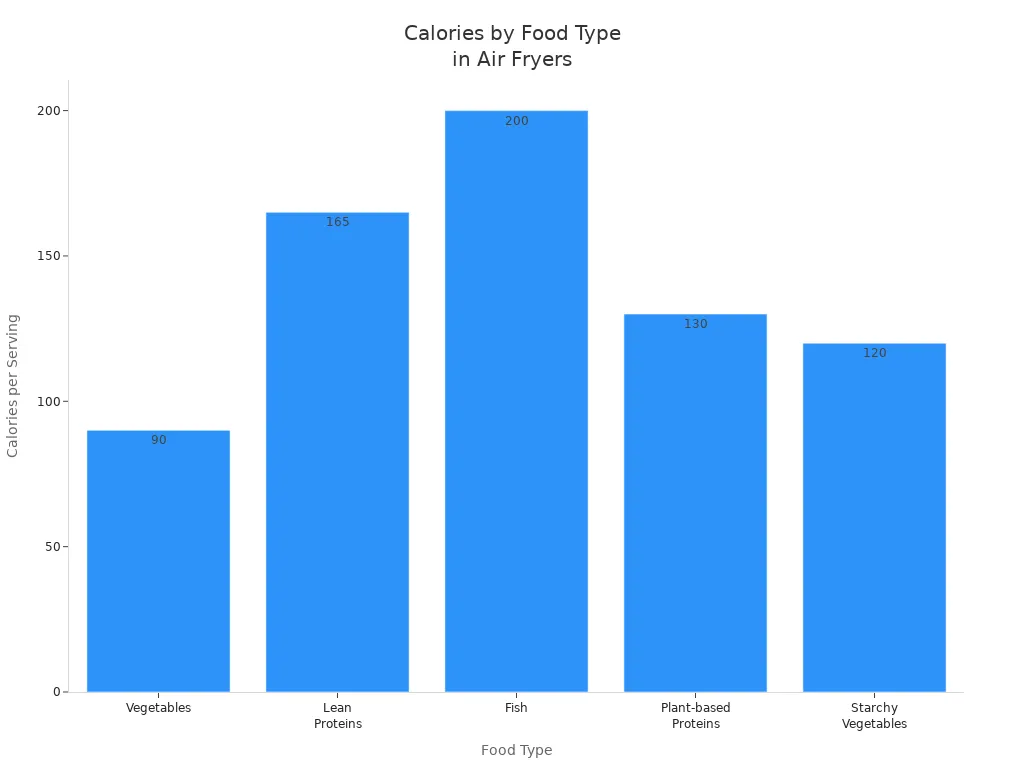
An Air Without Oil Fryer helps people enjoy favorite meals with less guilt. WebMD reports that air frying can cut calorie intake by 70% to 80% compared to deep frying. The table below highlights calorie savings per meal using an Electric Multi-Functional Air Fryer or an Electric Deep Fryer Air Fryer.
| Cooking Method | Oil Used | Calories from Oil | Typical Calorie Reduction per Meal |
|---|---|---|---|
| Air Frying | 1 tsp | ~42 calories | 70% to 80% fewer calories |
| Deep Frying | 1 tbsp | ~126 calories | N/A |
Many also choose an Instant Steam Air Fryer for a healthier kitchen routine.
How an Air Without Oil Fryer Works

Hot Air Circulation Technology
An Air Without Oil Fryer uses advanced hot air circulation technology to cook food quickly and evenly. The device contains a powerful heating element and a high-speed fan. The fan moves hot air rapidly around the food inside a compact cooking chamber. This process relies on convection heat transfer, which ensures that every surface of the food receives consistent heat.
The rapid movement of hot air removes moisture from the food’s surface. This action promotes the Maillard reaction, a chemical process that creates browning and crispiness. The result is a golden, crunchy exterior similar to deep-fried foods. The design often includes a perforated basket, allowing 360° air coverage. This setup ensures that the food cooks evenly and achieves a desirable texture.
Tip: The compact, air-tight chamber of an Air Without Oil Fryer helps concentrate heat, making the cooking process faster and more efficient than traditional ovens.
Minimal or No Oil Needed
One of the main advantages of an Air Without Oil Fryer is its ability to cook food with little or no oil. Traditional deep frying requires several cups of oil to submerge the food. In contrast, air frying uses only about one tablespoon of oil, or sometimes none at all. This drastic reduction in oil means fewer calories and less fat in every meal.
- Air frying mimics the heat flow of boiling oil, dehydrating food and allowing it to cook with minimal oil.
- The method results in much lower fat absorption compared to deep frying.
- Harmful substances, such as benzo[a]pyrene and acrylamide, form less frequently during air frying.
- Air fryers also reduce the emission of volatile organic compounds (VOCs) and other pollutants during cooking.
Research shows that air fryers can effectively cook a wide range of foods with minimal oil. The fan and filter plate inside the fryer ensure even heat distribution and help remove excess fat. This technology not only supports healthier eating but also creates a safer cooking environment by reducing harmful emissions.
Air Without Oil Fryer vs. Traditional Frying

Calorie and Fat Content Comparison
Air frying and deep frying create very different nutritional profiles. Deep frying submerges food in hot oil, which leads to significant oil absorption. This process increases both calorie and fat content. For example, one tablespoon of oil adds about 120 calories and 14 grams of fat to a meal. Foods cooked this way can have up to 75% of their calories come from fat. High fat intake from deep-fried foods links to heart disease and other health problems.
In contrast, an Air Without Oil Fryer uses rapid hot air circulation and requires little or no oil. This method reduces calories by 70-80% compared to deep frying. Fat content also drops because the food absorbs less oil. Studies show that air-fried French fries have about 27% fewer calories, and air-fried breaded chicken breast can have up to 70% less fat than their deep-fried versions. Lower oil use also means less risk of trans fat formation, which can harm cholesterol levels and heart health.
The table below highlights the main differences:
| Aspect | Deep Frying | Air Frying |
|---|---|---|
| Oil Usage | Food submerged in hot oil, high oil absorption | Uses rapid hot air, minimal oil absorption |
| Calorie Content | High; up to 75% of calories from absorbed fat | Reduces calories by 70-80% |
| Fat Content | High due to absorbed oil | Much lower fat content |
| Trans Fat Risk | Increased at high frying temperatures | Minimizes trans fat formation |
| Nutrient Retention | Nutrient loss can be higher | Better nutrient retention |
Note: Air frying not only reduces calories and fat but also helps retain more nutrients in food due to lower cooking temperatures and less oil.
Taste and Texture Differences
Taste and texture play a big role in how people choose their cooking methods. Deep frying creates a thick, crispy crust and a tender interior. Many people enjoy the unique crunch and rich flavor that comes from food cooked in hot oil. However, this method often leaves food greasy and heavy.
Air frying produces a different result. The crust is thinner, smoother, and more uniform. The texture is crisp and crunchy, but the food feels lighter and less oily. Studies show that air-fried foods have about 50-70% less oil content and up to 90% less acrylamide, a harmful compound formed during high-temperature frying. Air-fried French fries, for example, have higher moisture content and less surface damage than deep-fried fries. The taste remains appealing, with many consumers appreciating the reduced greasiness and positive sensory qualities.
Consumer studies reveal that 64% of people prefer air frying for breaded chicken fillets at home. They value the versatility, lighter texture, and less oily taste. While deep frying is still favored for certain meat textures, air frying stands out for its convenience and health benefits.
| Attribute | Air Frying Characteristics | Traditional Frying Characteristics |
|---|---|---|
| Oil Absorption | Much lower oil uptake | Much higher oil absorption |
| Crust Uniformity | Thinner, more homogeneous crust | Thicker, drier crust |
| Sensory Attributes | Preferred for crispness, firmness, and color; less oily | Favored for some textures but often considered greasy |
| Cooking Time | Longer cooking times | Faster cooking times |
| Environmental Impact | Reduced oil use, less waste, energy savings | Higher oil use, more environmental impact |
- Deep frying is often chosen for its meat texture but is seen as greasier.
- Air frying is appreciated for its crispness, reduced odor, and lighter feel.
- Many consumers prefer air-fried foods for their health benefits and convenience.
Tip: An Air Without Oil Fryer offers a way to enjoy crispy, tasty foods with fewer calories and less fat, making it a smart choice for healthier eating.
Health Benefits of Using an Air Without Oil Fryer
Lower Fat and Calorie Intake
Switching to an Air Without Oil Fryer can make a big difference in daily nutrition. This appliance cooks food with little to no oil, which means meals contain much less fat and fewer calories than those prepared by deep frying. Scientific studies show that air-fried foods can have up to 75% less fat, leading to a significant drop in calorie intake. Since fat is calorie-dense, this reduction helps people manage their weight more easily.
Air frying also lowers the intake of harmful trans fats, which are linked to heart disease, stroke, and diabetes. By using less oil, the Air Without Oil Fryer reduces the formation of acrylamide, a compound that may increase cancer risk. These changes support healthier blood pressure, cholesterol, and blood sugar levels.
Using an Air Without Oil Fryer allows families to enjoy crispy, tasty meals while making healthier choices every day.
Reduced Risk of Chronic Diseases
Choosing air frying over deep frying can help lower the risk of several chronic diseases. Researchers have found that air frying uses up to 90% less oil, which means fewer calories and less fat in each meal. This change can help prevent obesity and heart disease.
- Air frying produces fewer harmful compounds, such as advanced glycation end products (AGEs) and acrylamide, compared to deep frying.
- Lower levels of AGEs reduce inflammation and the risk of heart disease.
- Cooking with less oil supports better cholesterol management and helps maintain healthy blood sugar levels.
Smart temperature control and non-stick technology in modern air fryers further support heart health by preventing oil oxidation and reducing the need for extra fats. These features make the Air Without Oil Fryer a valuable tool for anyone looking to improve their long-term health.
Practical Tips for Maximizing Calorie Reduction
Choosing the Right Foods for Air Frying
Selecting the right foods can maximize calorie reduction. Vegetables, lean proteins, fish, and plant-based proteins work best in air fryers. Foods like bell peppers, zucchini, carrots, chicken breast, salmon, tofu, and sweet potatoes deliver excellent results with minimal oil. These options retain their nutrients and texture while reducing fat content. The table below shows how different foods benefit from air frying:
| Food Type | Example Foods | Cooking Method | Approximate Calories per Serving | Calorie Reduction Reason |
|---|---|---|---|---|
| Vegetables | Bell peppers, zucchini, carrots | Air fried with minimal oil | ~90 kcal | Reduced oil use compared to deep frying |
| Lean Proteins | Chicken breast | Air fried with minimal oil | ~165 kcal | Minimal oil, retains protein with less fat |
| Fish | Salmon, haddock, cod | Air fried with minimal oil | ~200 kcal | Less oil absorption than traditional frying |
| Plant-based Proteins | Tofu | Air fried with minimal oil | ~130 kcal | Minimal oil, maintains protein content |
| Starchy Vegetables | Sweet potatoes | Air fried with minimal oil | ~120 kcal | Lower oil content than deep-fried fries |

Tip: Fries, chicken wings, and vegetables like cauliflower and green beans show the greatest calorie savings when air fried.
Best Practices for Using an Air Without Oil Fryer
Nutritionists recommend several best practices for calorie reduction:
- Use minimal or no oil to cut fat and calories by up to 80%.
- Avoid overcrowding the basket to ensure even cooking.
- Shake or flip food during cooking for uniform crispiness.
- Preheat the fryer for about three minutes before adding food.
- Pat food dry to remove excess moisture.
- Season food before cooking for better flavor.
- Cook at the right temperature to reduce harmful compounds.
- Soak potatoes before air frying to lower acrylamide.
- Avoid overcooking to maintain food safety.
- Use a light spray or brush of oil, not aerosol sprays.
- Include a variety of vegetables and proteins for balanced meals.
- Monitor cooking times to prevent burning.
Common Mistakes to Avoid
Some mistakes can reduce the health benefits of air frying:
- Using too much oil increases calories and makes food soggy.
- Skipping oil entirely can cause dry, tough textures.
- Overcrowding the basket leads to uneven cooking and may require extra oil.
- Not drying food before cooking results in less crispiness and longer cook times.
- Air frying leafy greens like kale can cause them to dry out too quickly.
- Not cleaning the fryer regularly can lead to oil buildup and affect food quality.
Note: Blanching vegetables before air frying can improve texture and results.
Limitations and Considerations of Air Without Oil Fryers
Not All Foods Are Healthier When Air Fried
Air fryers offer a healthier alternative to deep frying, but not every food becomes healthier when cooked this way. Some foods, like fatty fish, may lose beneficial polyunsaturated fats during air frying. This process can also slightly increase cholesterol oxidation products, which may affect cholesterol levels. Cooking at high temperatures can produce polycyclic aromatic hydrocarbons (PAHs), though air fryers create less than traditional fryers.
Some air fryer models use nonstick coatings that contain polyfluorinated molecules (PFAS), sometimes called “forever chemicals.” Exposure to PFAS links to health risks such as hormone disruption, infertility, and certain cancers. While modern coatings are safer, users should avoid damaging or overheating the nonstick surface. Acrylamide, a compound linked to cancer in animal studies, can form in air-fried foods at levels similar to or higher than other methods, especially in potatoes. Pre-soaking potatoes before cooking helps reduce acrylamide formation.
Note: Relying on air fryers for daily meals may encourage frequent consumption of breaded, fried-style foods, which are often low in nutrients.
Adjusting Cooking Methods for Best Results
To get the best results from an air fryer, users should adjust their cooking methods. Preheating the air fryer for 3 to 5 minutes helps ensure even cooking and crispiness. Placing food in a single layer with space between pieces allows hot air to circulate and prevents sogginess. Using a light spray of oil can improve the texture of foods like potato wedges or chicken wings.
- Monitor cooking times closely, as air fryers cook faster than ovens or stovetops.
- Use temperature settings that match the food type, such as 400°F for fries or 350°F for vegetables.
- Keep the basket or lid closed during cooking to maintain heat.
- Clean the air fryer regularly to prevent buildup and maintain performance.
- Try different cooking methods, such as baking or steaming, to ensure a balanced diet.
Tip: Accessories like racks and trays can help cook multiple layers and improve air circulation.
Choosing air frying for daily meals leads to significant calorie and fat reduction. Studies show up to 80% fewer calories and 75% less saturated fat compared to deep frying.
| Benefit | Air Frying Result |
|---|---|
| Calorie reduction | Up to 80% |
| Lower saturated fat | 75% less |
| Improved heart health | Reduced cardiovascular risk |
| Safer cooking | Lower fire and burn risk |
People enjoy tasty, healthier meals while supporting long-term wellness.
FAQ
How much oil does an air without oil fryer need?
Most recipes require only one teaspoon of oil. Some foods cook well with no oil at all. This reduces fat and calorie intake.
Tip: Use a brush or spray for even oil distribution.
Can an air without oil fryer cook frozen foods?
Yes, an air fryer cooks frozen foods like fries, nuggets, and fish sticks. The hot air circulates quickly, making them crispy without extra oil.
Does air frying change the taste of food?
Air frying creates a crispy texture with less grease. The taste remains similar to deep-fried foods, but the food feels lighter and less oily.
Post time: Aug-05-2025

